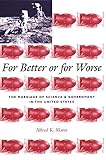For Better or for Worse : The Marriage of Science and Government in the United States / Alfred Mann.
Material type: TextPublisher: New York, NY : Columbia University Press, [2000]Copyright date: ©2000Description: 1 online resource (272 p.) : 59 halftones, 18 line artContent type:
TextPublisher: New York, NY : Columbia University Press, [2000]Copyright date: ©2000Description: 1 online resource (272 p.) : 59 halftones, 18 line artContent type: - 9780231117067
- 9780231505666
- 509.73 21
- Q127.U5 M36 2000eb
- online - DeGruyter
- Issued also in print.
| Item type | Current library | Call number | URL | Status | Notes | Barcode | |
|---|---|---|---|---|---|---|---|
 eBook
eBook
|
Biblioteca "Angelicum" Pont. Univ. S.Tommaso d'Aquino Nuvola online | online - DeGruyter (Browse shelf(Opens below)) | Online access | Not for loan (Accesso limitato) | Accesso per gli utenti autorizzati / Access for authorized users | (dgr)9780231505666 |
Frontmatter -- Contents -- List of Illustrations -- List of Tables -- Preface -- Chapter 1. Introduction -- Chapter 2. Love at First Sight: 1939-1945 -- Chapter 3. Courtship: 1945-1955 -- Chapter 4. Marriage: 1955-1965 -- Chapter 5. End of the Honeymoon: 1965-1975 -- Chapter 6. Estrangement and Reconciliation: 1975-1985 -- Chapter 7. Golden Anniversary: 1985-1995 -- Chapter 8. The Future: 2000 and More -- Notes -- References -- Index
restricted access online access with authorization star
http://purl.org/coar/access_right/c_16ec
The development of an American science establishment-today an amalgam of scientists, engineers, universities, industrial laboratories, and federal science agencies-began early in the twentieth century when the federal government began to invest in a national scientific infrastructure. During World War II this investment swelled to colossal proportions. At present, the yearly federal investment in basic science and technology amounts to about thirty-five billion dollars. How did this complex marriage between science and government occur? How will increasing economic pressures affect its future?In this engaging overview of the science establishment and its relationship with the federal government, renowned physicist Alfred K. Mann details the reasons behind the creation of the four nonmilitary federal science agencies that are responsible for the bulk of this budget and are the principal supporters of scientific research and technology in American universities. Looking into each agency, he elucidates the ways in which decisions were made, whose interests were at stake, and the resulting discoveries, mishaps, and bureaucratic mazes that were constructed in the name of research. Mann interweaves fascinating stories that grew out of the scientific enterprise: the allies' invention during World War II of the proximity fuse and its tremendous battlefield success, the first use of blood plasma in World War II field hospitals, the invention of radar, strategic policies of the Cold War, the double helix of DNA, space explorations and the space missions, modern global positioning systems (GPS), satellite surveillance, and recent declassification of covert operations. Charting the origins and operations of a remarkable collaboration, For Better or for Worse encompasses many of the key scientific discoveries of our time and offers a renewed vision of the future direction of the United States science establishment.
Issued also in print.
Mode of access: Internet via World Wide Web.
In English.
Description based on online resource; title from PDF title page (publisher's Web site, viewed 02. Mrz 2022)


